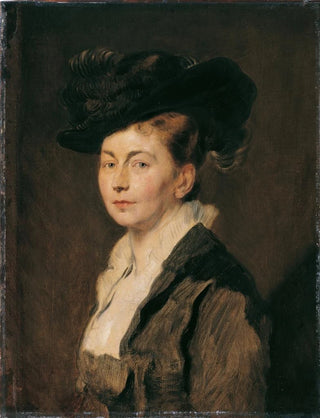Art print | Portrait of a lady - Hans Canon Source: Reproduction | Portrait d'une dame - Hans Canon


View from behind

Frame (optional)
Portrait of a Lady - Hans Canon – Captivating Introduction
The "Portrait of a Lady" by Hans Canon is a work that transcends time, an open window to a bygone era where art and life intertwine with rare delicacy. This painting, imbued with mystery and elegance, captures the very essence of its subject, revealing both outer beauty and inner depth. The artist manages to infuse a soul into his model, making this work much more than a simple portrait. In a world saturated with ephemeral images, this art print invites us to delve into a universe where every detail matters, where each brushstroke tells a story.
Style and uniqueness of the work
Hans Canon's style is distinguished by his ability to combine realism and romanticism. In "Portrait of a Lady," the finesse of the features and the subtlety of the colors create an intimate atmosphere, almost tangible. The artist skillfully plays with light and shadow, giving his model an almost lifelike presence. The lady's sumptuous clothing, as well as the accessories surrounding her, are rendered with such precision that they seem to vibrate under the viewer's gaze. Canon does not merely depict a female figure; he captures the essence of an era, the 19th century, when portrait art was synonymous with social status and refinement. Every element of the painting, from the delicately nuanced background to the subtle expressions on the face, demonstrates exceptional craftsmanship, making this work a true jewel of painting.
The artist and his influence
Hans Canon, 19th-century Austrian painter, is often recognized for his ability to immortalize the beauty and nobility of his models. Trained in the greatest ateliers, his talent quickly established itself, allowing him to carve out a place among the masters of his time. Canon drew inspiration from the major artistic currents of his era, while developing a personal style that is uniquely his own. His influence is felt not only in his portraits but also in the way he captured the spirit of his time. As an artist, he contributed to redefining the portrait as a genre, integrating a psychological dimension that goes to

Matte finish

View from behind

Frame (optional)
Portrait of a Lady - Hans Canon – Captivating Introduction
The "Portrait of a Lady" by Hans Canon is a work that transcends time, an open window to a bygone era where art and life intertwine with rare delicacy. This painting, imbued with mystery and elegance, captures the very essence of its subject, revealing both outer beauty and inner depth. The artist manages to infuse a soul into his model, making this work much more than a simple portrait. In a world saturated with ephemeral images, this art print invites us to delve into a universe where every detail matters, where each brushstroke tells a story.
Style and uniqueness of the work
Hans Canon's style is distinguished by his ability to combine realism and romanticism. In "Portrait of a Lady," the finesse of the features and the subtlety of the colors create an intimate atmosphere, almost tangible. The artist skillfully plays with light and shadow, giving his model an almost lifelike presence. The lady's sumptuous clothing, as well as the accessories surrounding her, are rendered with such precision that they seem to vibrate under the viewer's gaze. Canon does not merely depict a female figure; he captures the essence of an era, the 19th century, when portrait art was synonymous with social status and refinement. Every element of the painting, from the delicately nuanced background to the subtle expressions on the face, demonstrates exceptional craftsmanship, making this work a true jewel of painting.
The artist and his influence
Hans Canon, 19th-century Austrian painter, is often recognized for his ability to immortalize the beauty and nobility of his models. Trained in the greatest ateliers, his talent quickly established itself, allowing him to carve out a place among the masters of his time. Canon drew inspiration from the major artistic currents of his era, while developing a personal style that is uniquely his own. His influence is felt not only in his portraits but also in the way he captured the spirit of his time. As an artist, he contributed to redefining the portrait as a genre, integrating a psychological dimension that goes to






